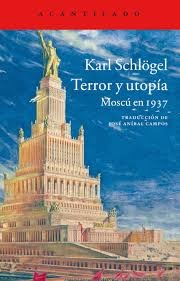
Original title: Terror and dream
Year of publication: 2008
Translation: José Aníbal Campos
Valuation: Almost essential
Two metaphors constitute the initial and final chapter of this mammoth work of just over 1,000 pages with which the German professor Karl Schlögel draws a panopticon of Moscow and the Soviet Union in the sadly famous year of 1937. They are not casual decisions, obviously.
The first, the choice of an analysis of The Master and Margarita by Bulgakov (mental note #1: I have to reread and review it) as the opening of the work, results from the structure that it will later adopt Terror and utopia, of that flight with which Bulgakov and Schlögel try to grasp the totality of Moscow life twenty years after the triumph of the Revolution. But not only that because, as happens in the novel, in Terror and utopia the unusual is no longer extraordinary.
The second, the choice of Boris Iofán’s gigantic Palace of Soviets, which was to be built on the remains of the demolished Cathedral of Christ the Redeemer and which was finally unfinished (partly due to the German invasion), serves as a perfect metaphor for the destiny of the USSR. .
In between, as I already said, thirty-eight chapters that cover almost all areas of the life of a year that has gone down in History through the Moscow Trials, but that contains aspects that have perhaps been forgotten or undervalued in the light of the terrible purges and massacres that devastated the country in those years (and before and after, mind you) and of which the 3 Moscow Trials are only a tiny percentage. Because Moscow in 1937 is not limited to politics.
In this way, Schlögel speaks of a country and a historical moment that may have been simplified in later years, but that hide a complexity that makes Moscow and 1937 a place and time as terrible as it is fascinating, at least for me. In this way, we know a country that constitutes an immense social laboratory, which is immersed in a series of demographic changes due to forced collectivization and industrialization, which results in a quicksand society that a Party weakened by purges and nepotism seems incapable of to control, but also a country that plays with modernity in the artistic/cultural sphere, that advances like few places have done in such a short space of time.
Moscow in 1937 is a place and time of synthesis and homogenization but also of crisis, of permanent state of exception, with power weakened at its foundations, with a social order in precarious balance, etc. Changes and situations that cause this new social order of which the 1937 Census (in view of the December elections) echoes, of which the General Reconstruction Plan of Moscow (1935) is a reflection, and which represents a paradigm shift in all areas: economic, cultural, artistic, work, political, or even physical, etc. Nothing escapes this new country that is being built, this new identity that the highest authorities are trying to create, and for this they serve art, the new mass media, propaganda, parades, geographical discoveries, etc. and, above all, , political violence. Because nothing better than a more or less imaginary enemy against which to “join forces.”
All this is what Schlögel shows in this monumental Terror and utopia. To do this, it uses archives and publications of the time, minutes, subsequent studies, testimonies from foreigners (those from Lion Feuchtwanger and the American ambassador Joseph Davies stand out) or from nationals such as Yelena Bulgakova.
If I had to stay with something Terror and utopia, In addition to the author’s merit in making a reading of about 1000 pages (and such a dense topic) relatively enjoyable, it is with that global vision that goes beyond reductionisms and that makes the book work both as a sociopolitical essay. , cultural report or horror novel (considering “the crimes part” of 2666 as a horror novel). Moscow in 1937 is, at the same time, a social laboratory, a recruiting ground and avant-garde of artistic and cultural currents, but almost none of this is isolated. Moscow in 1937 does not exhaust itself in politics but politics “infects” almost all fields.
On the less positive side, I have the impression that Schlögel leaves out Stalin’s personality cult. He is mentioned, he appears there, but I would like to know how it is forged, what are the mechanisms that lead a people to such blindness that allows similar atrocities is something that would deserve more space in the text. I mean.
In any case, I think Terror and utopia It is an essential text for anyone interested in the subject, a thread to pull towards other readings that deepen or complete (Bulgakov, Platonov, Robert Conquest, Feuchtwanger, Bukharin, Ordzhonikidze, Soviet cinema or architecture, the construction of the Volga-Moscova canal, concentrationarian literature, etc.) what has already been noted in the text. There is a task ahead.
Source: https://unlibroaldia.blogspot.com/2024/05/karl-schlogel-terror-y-utopia-moscu-en.html


